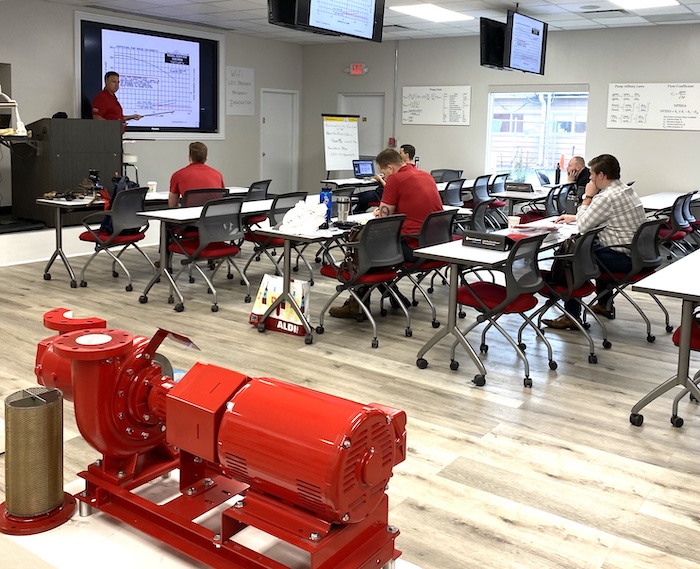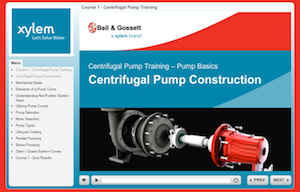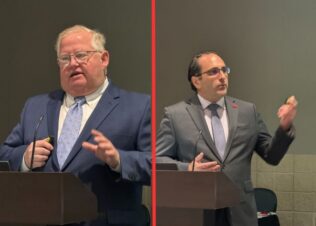By Norman Hall

Mike LiCastro reviews pump curves at the Bell & Gossett Little Red School House.
Your new employee is in the job and doing great. You used a system, as mentioned in part 1, to introduce the employee to the company core values and team members. Now, how do you increase their value to your customers? By enhancing their knowledge. In this article we will walk through the system we use at R. L. Deppmann to train new hires on hydronic system design and product knowledge.
The Hydronic System Training Program – Step by Step
A perfect example to get us in the long-term training mindset is to think about the key educational stages in a medical career. Think of your long-term heating and cooling training program for employees as a series of steps. A basic overall “pre-med” program for hydronic system parts and pieces. Then you move to a “med-school” program where the employee learns a lot of detailed things needed in the job. A “residency” program allows them to use the knowledge with little supervision or oversite. This is where they may choose to become an expert in some area of interest.
Internally we refer to this program as our “Doctoral Program.” While not a formal official university program, this metaphor works well to help the new hire understand that they will increase their knowledge and expertise in stages
This outline for training may be used for any job classification: product salespeople, customer service, estimation, and even startup personnel. Let’s use an example of a startup technician.
The Start-up Technician Job Overview
- L. Deppmann (RLD) is a manufacturer’s representative. We startup pumps, boilers, steam condensate units, and packaged heat transfer and water heater systems. Our technicians do much more than a startup. We also get calls to assist contractors and plumbers in troubleshooting system issues. Obviously, the more seasoned technicians are more knowledgeable. What does their training program look like?
The Start-Up Tech ‘Doctoral’ Program
Part One: “Pre-Med.” Our technicians need to understand a great deal about how hydronic, steam, and plumbing systems work. This portion of training involves understanding the parts and pieces of each system and why they exist. This stage of training is done concurrently with the “hands-on” knowledge. The tech can be, for example, aligning pumps and basic startups most of the week. Their designated pre-med training happens just 4-6 hours per week. Most of it uses existing training programs internal to RLD or from other sources. One example is the Bell and Gossett Little Red Schoolhouse e-learning program.

As an example, let’s think of the air control portion of a hydronic system. This part one training would include “what they are” and “why they exist” for cold fill reducing valves, pressure relief valves, expansion tanks, air/dirt separators, and air vents.
This is the same knowledge an estimator or outside salesperson would need.
Part Two: “Med School.” This portion of the training plan really focuses on what can go wrong in the system or equipment as well as what can cause the issue. It now gets into the details of troubleshooting and servicing the equipment.
Keeping with the air control system example. How to set the cold fill pressure. How to replace an expansion tank bladder. Identifying the point of no pressure change issues.
This is where we introduce in-person classes at some of the manufacturers as formal training. An example is the Xylem Bell & Gossett Little Red School House in Morton Grove, Illinois. Once someone understands the basic what and why from part one, they are ready for the subject immersion of these classes.
“Med school” can go on for years depending on the number of opportunities to gain experience. Like gaining one’s medical degree, expertise in our industry is a marathon, not a sprint. The focus here is not on knowing how to do the day-to-day of one’s job, but rather mastery of their field. This takes time and patience.
Part Three: “Residency.” Now the Tech is ready to go beyond their basic job. Here they learn that trouble caused to one piece of equipment may be due to another. A true understanding of how everything interacts in the mechanical room. They are also able to train new people and customers at this point.
Using our air control example once again. How does a nuisance call about poor heating on the top floor lead the tech to check the cold fill pressure settings?
Multiple Concurrent Paths to Knowledge
Remember that an employee could be at multiple levels of knowledge at the same time. Someone could be done with air control med school knowledge while being in pre-med for steam and residency for boilers.
The team leader or manager is responsible for keeping “degree” records and identifying the order of subjects to be learned. This is a key success factor to the program. Knowledge and the ability to use it should be woven into employee accountabilities, reviews, one-on-one meetings, and even salary levels. The leader must understand the program and own it in order to seamlessly integrate it into the culture of their team and motivate employees to seek a higher understanding of their industry.
Your program will look different than mine. Any employee training program will help your company. You just need to commit to this fact: you cannot afford not to invest in new employee training.
 Norman Hall is an engineer and leader at the R. L. Deppmann Company, a manufacturer’s representative, in Michigan and Ohio. Norm has assisted in the design and troubleshooting of hydronic and steam systems for 45 years.
Norman Hall is an engineer and leader at the R. L. Deppmann Company, a manufacturer’s representative, in Michigan and Ohio. Norm has assisted in the design and troubleshooting of hydronic and steam systems for 45 years.



